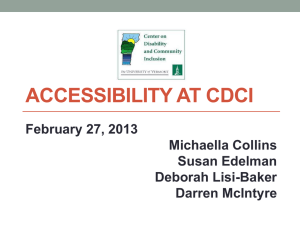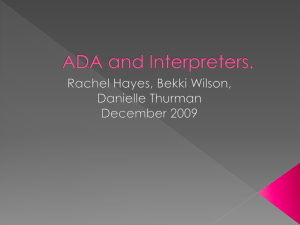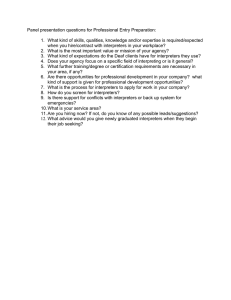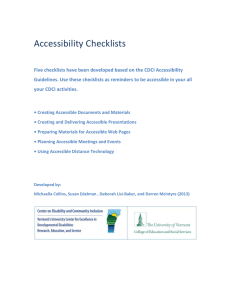CDCI Accessibility Self-Assessment
advertisement
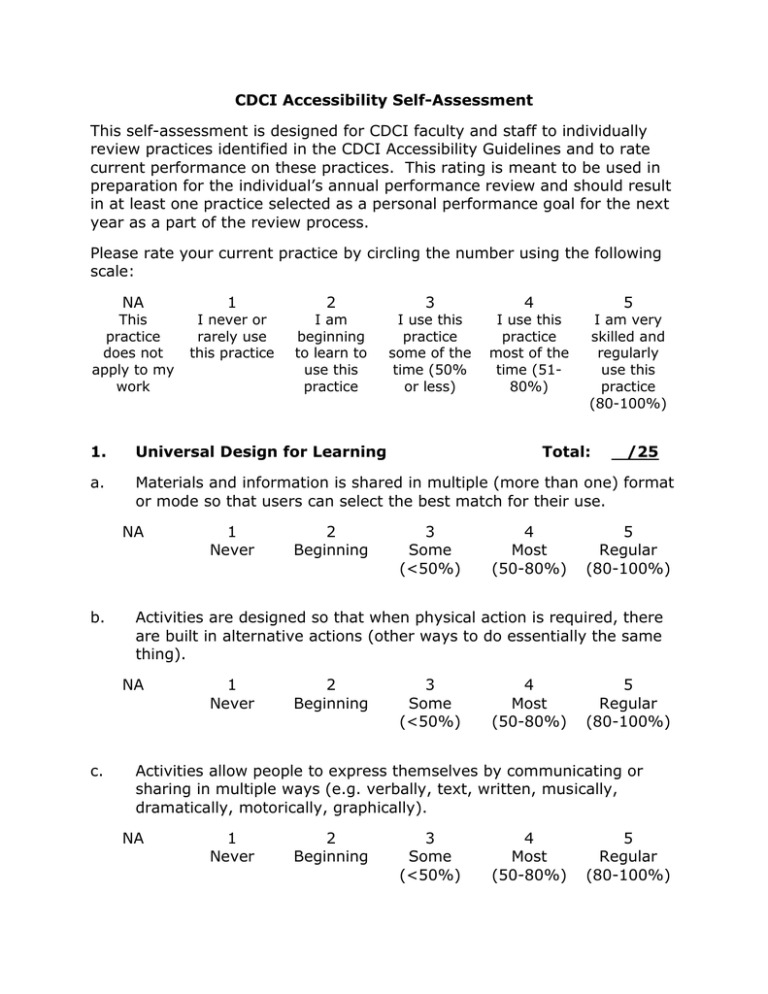
CDCI Accessibility Self-Assessment This self-assessment is designed for CDCI faculty and staff to individually review practices identified in the CDCI Accessibility Guidelines and to rate current performance on these practices. This rating is meant to be used in preparation for the individual’s annual performance review and should result in at least one practice selected as a personal performance goal for the next year as a part of the review process. Please rate your current practice by circling the number using the following scale: NA This practice does not apply to my work 1 I never or rarely use this practice 2 I am beginning to learn to use this practice 3 I use this practice some of the time (50% or less) 4 I use this practice most of the time (5180%) 5 I am very skilled and regularly use this practice (80-100%) 1. Universal Design for Learning a. Materials and information is shared in multiple (more than one) format or mode so that users can select the best match for their use. NA b. 2 Beginning 3 Some (<50%) 4 Most (50-80%) /25 5 Regular (80-100%) Activities are designed so that when physical action is required, there are built in alternative actions (other ways to do essentially the same thing). NA c. 1 Never Total: 1 Never 2 Beginning 3 Some (<50%) 4 Most (50-80%) 5 Regular (80-100%) Activities allow people to express themselves by communicating or sharing in multiple ways (e.g. verbally, text, written, musically, dramatically, motorically, graphically). NA 1 Never 2 Beginning 3 Some (<50%) 4 Most (50-80%) 5 Regular (80-100%) d. Learning activities are designed to build upon prior knowledge and experience of participants. NA e. 1 Never 2 Beginning 3 Some (<50%) 4 Most (50-80%) 5 Regular (80-100%) Activities are set up so that there are supports such as checklists, guides, rubrics, or exemplars to assist people to participate successfully. NA 1 Never 2 Beginning 3 Some (<50%) 4 Most (50-80%) 5 Regular (80-100%) Add your ratings for this section and enter the total at the top of this section. 2. Attitudes and Actions a. Disability and Deaf organizations are used as resources and partners in the community and in outreach. NA b. 2 Beginning 3 Some (<50%) 4 Most (50-80%) /25 5 Regular (80-100%) “People-first” language is used as is other disability/Deaf etiquette. NA c. 1 Never Total: 1 Never 2 Beginning 3 Some (<50%) 4 Most (50-80%) 5 Regular (80-100%) History and laws related to disability are familiar. NA 1 Never 2 Beginning 3 Some (<50%) 4 Most (50-80%) 5 Regular (80-100%) d. Deaf and disability awareness activities are incorporated in my work. NA e. 1 Never 2 Beginning 3 Some (<50%) 4 Most (50-80%) 5 Regular (80-100%) UVM services and supports for accessibility and inclusion are well known and regularly used. NA 1 Never 2 Beginning 3 4 5 Some Most Regular (<50%) (50-80%) (80-100%) Add your ratings for this section and enter the total at the top of this section. 3. Creating Accessible Documents and Materials a. A text-only version is available for all materials. NA 1 Never 2 Beginning 3 Some (<50%) Total: 4 Most (50-80%) /40 5 Regular (80-100%) b. Materials are designed using styles and are clearly organized and easy to follow. NA c. 1 Never 2 Beginning 3 Some (<50%) 4 Most (50-80%) 5 Regular (80-100%) Alternative text (alt tags) are used for all images. NA 1 Never 2 Beginning 3 Some (<50%) 4 Most (50-80%) 5 Regular (80-100%) d. For Word documents standard fonts with minimum 12 point size are used and special formatting is minimal. NA 1 Never 2 Beginning 3 Some (<50%) 4 Most (50-80%) 5 Regular (80-100%) e. For power point presentations 44-point font is used for headings and 32 point for bullets with no more than 6 lines per page. NA f. 3 Some (<50%) 4 Most (50-80%) 5 Regular (80-100%) 1 Never 2 Beginning 3 Some (<50%) 4 Most (50-80%) 5 Regular (80-100%) Materials are previewed by an independent person before distributing. NA h. 2 Beginning OCR (optical character recognition) is used for PDF documents. NA g. 1 Never 1 Never 2 Beginning 3 Some (<50%) 4 Most (50-80%) 5 Regular (80-100%) Materials are provided in multiple formats. NA 1 Never 2 Beginning 3 4 5 Some Most Regular (<50%) (50-80%) (80-100%) Add your ratings for this section and enter the total at the top of this section. 4. Creating and Delivering Accessible Presentations Total: a. Speech is clear and well-paced for interpreter understanding. NA 1 Never 2 Beginning 3 Some (<50%) 4 Most (50-80%) /20 5 Regular (80-100%) b. c. d. Language is simple and avoids acronyms, jargon, and idioms. NA 1 Never 2 Beginning 3 4 Some Most (<50%) (50-80%) Processing time is allowed with pauses between topics. NA 1 Never 2 Beginning 1 Never 2 Beginning 3 Some (<50%) 4 Most (50-80%) 5 Regular (80-100%) 1 Never 2 Beginning 3 Some (<50%) 4 Most (50-80%) 5 Regular (80-100%) All relevant sound/voice is shared through the microphone including audience questions and comments. NA g. 5 Regular (80-100%) A microphone is used and there is not reliance solely on asking the audience if they can hear. NA f. 4 Most (50-80%) Positioning in the room or space allows good visibility of the speaker’s face. NA e. 3 Some (<50%) 5 Regular (80-100%) 1 Never 2 Beginning 3 Some (<50%) 4 Most (50-80%) 5 Regular (80-100%) All key information on slides is voiced or covered. NA 1 Never 2 Beginning 3 Some (<50%) 4 Most (50-80%) 5 Regular (80-100%) h. Graphics, photos, video images and other visuals relevant to understanding the material are described verbally. NA i. 1 Never 2 Beginning 3 Some (<50%) 4 Most (50-80%) Describe other visual information to the audience offering a summary of what is seen. (For example the speaker asks, "If you make your websites fully accessible, please raise your hand."...then says, "about half raised their hand."). NA 1 Never 2 Beginning 3 Some (<50%) 4 Most (50-80%) 5. Preparing Materials for Accessible Web Pages a. Text descriptions are provided for all images. NA b. 2 Beginning 3 Some (<50%) Total: 4 Most (50-80%) /50 5 Regular (80-100%) 1 Never 2 Beginning 3 Some (<50%) 4 Most (50-80%) 5 Regular (80-100%) 4 Most (50-80%) 5 Regular (80-100%) Text is clearly written and easy to read. NA d. 1 Never 5 Regular (80-100%) All content can be accessed by keyboard alone, not just mouse. NA c. 5 Regular (80-100%) 1 Never 2 Beginning 3 Some (<50%) Content is organized and written with headings to convey meaning. NA 1 Never 2 Beginning 3 Some (<50%) 4 Most (50-80%) 5 Regular (80-100%) e. Meaning is not conveyed by color alone. NA f. 5 Regular (80-100%) 1 Never 2 Beginning 3 Some (<50%) 4 Most (50-80%) 5 Regular (80-100%) 1 Never 2 Beginning 3 Some (<50%) 4 Most (50-80%) 5 Regular (80-100%) 1 Never 2 Beginning 3 Some (<50%) 4 Most (50-80%) 5 Regular (80-100%) 3 Some (<50%) 4 Most (50-80%) 5 Regular (80-100%) Forms are accessible for all users. NA j. 4 Most (50-80%) Links have descriptive names. NA i. 3 Some (<50%) There are no animated or flickering elements. NA h. 2 Beginning Captions are provided for videos and transcripts are provided for audio. NA g. 1 Never 1 Never 2 Beginning When an application or plug-in is required, the link for this is provided. NA 1 Never 2 Beginning 3 Some (<50%) 4 Most (50-80%) 5 Regular (80-100%) 6. Planning Accessible Meetings and Events a. Speakers and participants are asked in advance and at the start of the event is they have accessibility requirements. NA b. 4 Most (50-80%) 5 Regular (80-100%) 1 Never 2 Beginning 3 Some (<50%) 4 Most (50-80%) 5 Regular (80-100%) 1 Never 2 Beginning 3 Some (<50%) 4 Most (50-80%) 5 Regular (80-100%) Space is set up so as to enable good visibility of speakers and interpreters including lighting, distraction-free backgrounds such as bright sunlight, media screens or flashing light. NA e. 3 Some (<50%) Adequate sound system is in place and microphones are available. NA d. 2 Beginning /30 The facility and area spaces are accessible to speakers and participants including meeting rooms, bathrooms, presentation stage, refreshment and breakout spaces. NA c. 1 Never Total: 1 Never 2 Beginning 3 Some (<50%) 4 Most (50-80%) 5 Regular (80-100%) Assistive learning devices are arranged for such as interpreters, CART, hearing loops or interpreter relay services. NA 1 Never 2 Beginning 3 Some (<50%) 4 Most (50-80%) 5 Regular (80-100%) f. Internet connection has sufficient capacity to carry any and all planned internet use. NA 1 Never 2 Beginning 3 Some (<50%) 4 Most (50-80%) 5 Regular (80-100%) 7. Accessible Distance Technology a All online materials are available in accessible, multiple formats. NA b. 4 Most (50-80%) 5 Regular (80-100%) 1 Never 2 Beginning 3 Some (<50%) 4 Most (50-80%) 5 Regular (80-100%) 1 Never 2 Beginning 3 Some (<50%) 4 Most (50-80%) 5 Regular (80-100%) All materials are also available in text-only format. NA e. 3 Some (<50%) When real-time, synchronous communication is used an alternative method of communication is provided for those who cannot fully participate (i.e. an interpreter, captioning, etc.). NA d. 2 Beginning /40 A statement is provided onlne as to how to obtain alternate formats. NA c. 1 Never Total: 1 Never 2 Beginning 3 Some (<50%) 4 Most (50-80%) 5 Regular (80-100%) Videos are captioned and audio descriptions are provided for those who are blind or visually impaired. NA 1 Never 2 Beginning 3 Some (<50%) 4 Most (50-80%) 5 Regular (80-100%) f. For synchronous events (same time, different place), consideration is given to how participants will interact whether they may be on-site and/or off-site. NA g. 2 Beginning 3 Some (<50%) 4 Most (50-80%) 5 Regular (80-100%) For asynchronous events (different time, different place), recordings stored are accessible in each in audio, text, and, video. NA h. 1 Never 1 Never 2 Beginning 3 Some (<50%) 4 Most (50-80%) 5 Regular (80-100%) Instructions are provided in how to access recorded events. NA 1 Never 2 Beginning 3 Some (<50%) 4 Most (50-80%) 8. Accessible Offices at CDCI a. Visitors are contacted in advance to determine any support or accomodations needs such as interpreters, drivers, microphones, diet restrictions or environmental allergies, need for information in specific formats, a pre-meeting to go over meeting agenda and content. NA b. 1 Never 2 Beginning Total: 5 Regular (80-100%) 3 Some (<50%) 4 Most (50-80%) /45 5 Regular (80-100%) Interpreters, drivers and other services are scheduled and confirmed before finalizing a meeting date. NA 1 Never 2 Beginning 3 Some (<50%) 4 Most (50-80%) 5 Regular (80-100%) c. Materials in meetings are provided in accessible formats. NA d. 5 Regular (80-100%) 1 Never 2 Beginning 3 Some (<50%) 4 Most (50-80%) 5 Regular (80-100%) 1 Never 2 Beginning 3 Some (<50%) 4 Most (50-80%) 5 Regular (80-100%) 1 Never 2 Beginning 3 Some (<50%) 4 Most (50-80%) 5 Regular (80-100%) A clear path of travel from outside the building to meeting spaces, bathrooms, and other rooms people use. NA h. 4 Most (50-80%) Guests are met at the entrance if help is needed. NA g. 3 Some (<50%) Guided tours of CDCI is provided to visitors including individuals with varying abilities and communication needs. NA f. 2 Beginning Information is made in advance about accessible parking, guest parking permits, and elevator access. NA e. 1 Never 1 Never 2 Beginning 3 Some (<50%) 4 Most (50-80%) 5 Regular (80-100%) Doorways, paths, and aisles are clear of clutter and seating or room layout ensure adequate space for wheelchairs, interpreters, service animals, and other accommodation supports. NA 1 Never 2 Beginning 3 Some (<50%) 4 Most (50-80%) 5 Regular (80-100%) i. NA Emergency exit procedures are clear and well known. 1 Never 2 Beginning 3 Some (<50%) 4 Most (50-80%) 5 Regular (80-100%) SELF ASSESSMENT SUMMARY: 1. Universal Design for Learning Total: /25 2. Attitudes and Actions Total: /25 3. Creating Accessible Documents and Materials Total: /40 4. Creating and Delivering Accessible Presentations Total: /20 5. Preparing Materials for Accessible Web Pages Total: /50 6. Planning Accessible Meetings and Events Total: /30 7. Accessible Distance Technology Total: /40 8. Accessible Offices at CDCI Total: /45 OVERALL TOTAL: Total: /275
